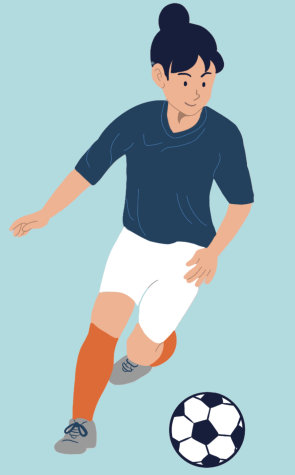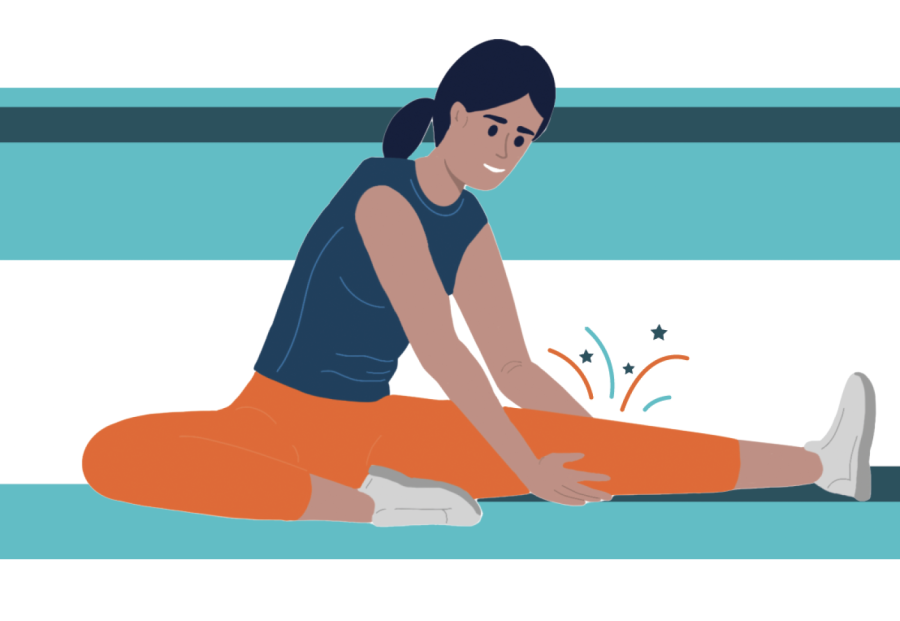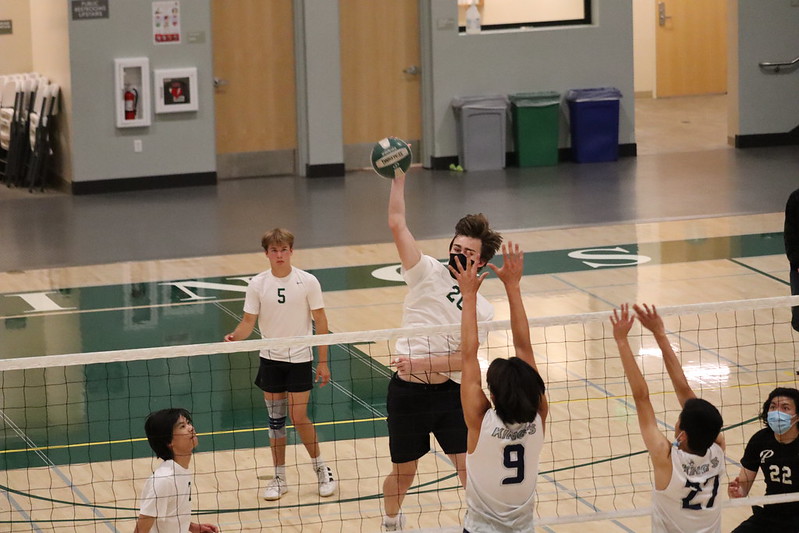Was It Worth It? Playing through Pain
February 24, 2023
Contact is a part of nearly every sport. In football, players tackle each other. Water polo players battle for position. Runners have repetitive contact with the ground. Soccer players head the ball. However, across all sports, contact poses risks. Concussions, torn muscles, and damaged bones or joints are ubiquitous parts of athletics. But how do Paly athletes deal with injuries that come with their sports, acute or chronic?
Football is generally the first sport people think of when they think of contact sports. In football, collisions are an unavoidable and essential part of the sport. There has been controversy about the safety and concussion protocols of football for a long time. But recently, with the shocking cardiac arrest on field of Buffalo Bills safety Damar Hamlin in January, more serious questions are being raised about the sport’s safety. How can we keep athletes safe while preserving the nature of football?
Here at Paly, one football player estimates that each player on his team gets concussed once every two seasons, meaning on average the athletes are getting two concussions over the four years in high school.
One concussion on developing brains is bad enough. According to the American Association of Neurological Surgeons, concussions can leave lasting damage like irregularity in mood, insomnia or memory loss.
However, if someone gets more than one concussion, especially if the brain has not fully recovered, these symptoms can worsen or last for longer. If the two concussions are close enough together in timeframe, an athlete can develop Second Impact Syndrome (SIS). According to RevereHealth, (SIS) causes the brain to swell rapidly and press against the skull, which can cause death in a manner of minutes following the concussion. It is a rare injury, but it is fatal around 50% of the time and will almost always lead to permanent brain damage and disability. Shockingly, the people at highest risk for SIS are high school athletes who play high contact sports. Around 95% of people with SIS are under 18.
It is crucial to avoid concussions, and if athletes do get a concussion, it is crucial that they observe proper protocols to ensure their safety.
These kinds of acute injuries are generally common in intense contact sports like football.
Isaiah Walker (‘25), a Paly football player, speaks about his experience with the safety protocols and concussions.
“We have to go to the doctor [if we get concussed] and then they give us a paper, basically working on our comeback,” Walker said. “It is tiny steps, starting with 10 minutes on a bike, working up to full practice again. I think [the doctors] are very effective because they are extremely cautious and force us to take our time.”
Many people worry about safety in football, but here at Paly, Walker feels that his chances of injury are minimized.
“I think although football is a physical sport, there are ways that it is safe,” Walker said. “Injuries are gonna happen, but with all the new gear and stuff we have for protection, it minimizes injuries a lot.”
Water polo is another sport with a threat of acute injuries from contact. Many water polo players are constantly bashed around and kicked underneath the water, emerging with bruises and scratches.
Some safety procedures for water polo include rules that punish players for excessive violence. This call is called ‘brutality,’ which can occur when a player draws blood via a scratch or punch, indecently exposes another player, or hits another player on purpose. It leads to a player being excluded for the remainder of the game, and in tournaments, the suspension may last longer than just one game.
However, some of the most dangerous injuries in the sport occur above the surface. If a player gets hit in the head with a shot or a pass, concussions can occur.
Mary Henderson (‘24), a goalie on the Paly girls water polo team, speaks to the frequency of concussions for goalies in particular, who sometimes get hit when a shot bounces off the frame of the cage at the wrong angle.
“Almost every goalie that I [have] talked to has … had multiple concussions,” Henderson said.
Water polo is a sport that lacks safety gear; players’ only form of protection is to wear a cap with plastic to protect their ears. Because of this increased risk for goalies, some wear a padded cap during practices.
However, concussions are still frequent. According to Head Case Company, one in five high school athletes will get concussed in a single season. For further protection against concussions, here at Paly, players check for concussions using the app HitCheck.
Developed by a software company in San Francisco, HitCheck is an app used by the water polo, lacrosse, basketball, and football teams at Paly, among others. The app has a video game design and administers a series of tests to determine whether a player has a concussion. With Hitcheck, the process is as simple as taking a short series of tests which check for memory, balance, reaction time, coordination, and many more. The athlete takes a baseline test before the season, when their brains are healthy. Then, if they get hit on the head, the athlete will take the same tests again. The app then compares the results with the baseline test to measure whether cognitive function is intact. They are crucial in identifying concussions.
Paly athletic trainer Ms. E. thinks the app is a good way to protect athletes.
“I like Hitcheck because it’s portable, everyone has access to it, and then it hits those things that I want to see,” Ms. E. said.
Although the head is a very sensitive part of the body, in other sports, like soccer or running, the legs are what take the brunt of the activity. As captain of the girls soccer team, Kiana Feldis (‘24) has had experience with the injuries afflicting both herself and her teammates.
“Torn ACLs happen a lot in soccer,” she said, “Also, ankle injuries happen a lot, and a lot of pulled muscles, like hamstrings and quads.”
According to Wentworth-Douglass Hospital, one in 20 female soccer players will tear their ACL each year they play. This devastating injury to the tendon crossing the knee can often warrant surgery and will always require a long period of recovery, which keeps the athlete out of her sport, which can be emotionally devastating. Despite never having a torn ACL, Feldis has been faced with long recovery periods from a broken ankle.
“When I broke my ankle, I was out for almost three months,” Feldis said. “It’s definitely really, really hard to be watching your team play and not be able to play. I went to every single practice when I was injured and I couldn’t play. Spending time with my teammates … is probably the best thing that helped me get through it.”
To prevent injuries, soccer players must focus on certain aspects of their play.
“Warming up definitely is really important, stretching, doing strengthening exercises can help [avoid injury],” Feldis said. “Also don’t go into dangerous tackles. Don’t tackle someone late. Just try and keep your balance [to prevent] bad falls.”
Just like in soccer, runners can become injured from protracted impact. Each stride, a runner’s weight is slammed onto the knees and ankles, which, over long periods of time, can lead to injuries like shin splints, which are small tears in muscle tissue in the calves and ankles as a result of overuse, or stress fractures, which are minute breaks in bones. Usually these occur in a runner’s feet as a result of the intense pressure put on those small bones upon impact with the ground.
Any sport with running can have injuries like this, but track and cross country runners are especially at risk of developing these types of injuries.
Cross country runner Brooke Threlkeld (‘23) describes the familiarity of being injured.
“Basically every season, most people have at least one injury for a little bit,” Threlkeld said.
The cross-country team can run as many as ten miles in a single practice, usua lly running around 36 miles in a week. These large practices create a high possibility of chronic injuries developing, especially if athletes go from not running at all to running long distances.
lly running around 36 miles in a week. These large practices create a high possibility of chronic injuries developing, especially if athletes go from not running at all to running long distances.
Because of this, warming up and stretching in cross country are important parts of the routine to stay healthy.
“We do a lot of stretching and a lot of warming up,” Threlkeld said. “We usually run a mile to warm up and [then] do about ten minutes of stretching. And then we’ll do dynamic warm ups. I think the combination of doing dynamic warm ups and stretching really helps to get your muscles prepared to work out.”
According to the Mayo Clinic, warming up is crucial to preventing injuries. Giving around 40% to 60% effort on a warm up is optimal to give your cardiovascular system a chance to gradually increase blood flow instead of rapidly kicking into gear, creating unnecessary strain on your heart. It also protects your muscles, by literally warming them up, increasing the temperature and the oxygen flow. It also has been found to help stem the excessive buildup of chemicals which can be associated with pain felt during a workout.
Since it is a high impact sport, it is difficult for runners to continue working through injuries if they do get hurt.
“In running, there’s so much pressure and it’s a lot harder on your bones and joints, so people can’t really run through [injuries],” Threlkeld said.
Because of this, the cross-country coach is vigilant in the maintenance of the athletes’ health.
“Our coach is very good about being like, ‘Hey, if you feel anything, you have to tell me because I’ll work with you to work around it and recover,’” Threlkeld said. “People know that he will listen to them and help them through it.”
The positive culture encouraging recuperation helps the athletes return to form as quickly as possible.
However, not all teams place health above performance. In many teams, it is a mix between athletes not alerting their coaches about injuries and coaches not being adept at identifying injuries. The result of this is athletes playing in games despite being injured in order to not miss out on playtime. This is most commonly practiced in sports like baseball and basketball.
In baseball, stress fractures in the arm are frequent among players. Many players try to forget the sharp pain in their elbows or shoulders in hopes of playing a game. Advil is used to numb players’ pain, but playing on these injuries often leads to exacerbation of injuries, sometimes warranting surgery. There are few safety precautions for arm injuries due to the lack of players speaking up about their discomforts.
This practice of discounting pain is commonplace in many sports. Basketball is another sport where athletes often ignore injuries to continue playing.
Paly senior Mert Yanar is one basketball player who knows the consequences of playing through pain.
“In [a recent] tournament, I got injured with a few minutes to go,” Yanar said. “Since it was a tight game, I fought through the pain and finished the game. However, I wasn’t able to play in the tournament championship the next day because of it.”
Although playing on an injury may seem beneficial for playtime in the short term, not only is the trade-off not worth it, but long-term effects can be devastating. A simple ankle sprain, under appropriate care, can be healed in one to three weeks, but if not properly cared for, the injury can worsen, according to Paly’s athletic trainer, Ms. E.
“Someone who doesn’t let [their ankle] fully heal just loosens the ligaments to where they would have to surgically get it tightened,” Ms. E. said.
Prolonged use of a sprained ankle puts athletes at risk of developing chronic ankle pain and arthritis. Severe injuries like chronic pain and arthritis could take three to six months to heal.
“A small injury could progress to something worse because you start to develop an instability,” Ms. E. said.
According to the National Library of Medicine, ankle sprains account for 13.2% of all injuries in the NBA. However, ankle sprains are only 8.8% of the reasons players miss games, meaning players play on their injured ankles and risk worse injuries.
This pressure to play is not only on a professional level. Yanar feels it in high school basketball games as well.
“There’s definitely some pressure [to keep playing] with minor injuries from coaches and teammates,” he said. “For example, I sprained my finger in the first quarter of our Saratoga game, but I knew I couldn’t sit out because of a finger injury, so I just taped it up and kept going.”
But it’s not just basketball and baseball. Water polo players frequently play through injuries as well.
A common injury for goalies is jammed fingers, which can lead to developing stress fractures as a result of blocking hard shots. However, for this specific injury, most doctors will say that goalies can continue playing with the broken finger because stress fractures in fingers generally don’t get worse after they have been formed.
Henderson, who plays water polo, has been playing with a fracture in her finger for many games and practices ever since she was injured in January.
“I had to keep playing, which was more difficult,” Henderson said. “There’s a lot of pressure to continue to play on the injury because when you take a break, it definitely feels like you’re [falling] behind.”
Many goalies play with this kind of injury, as well as others.
“Almost every goalie that I talked to has broken at least one finger, if not more,” Henderson said. “The same thing with concussions; they’ve often had multiple concussions.”
To avoid these actions and promote safe play, awareness should be spread about the dangers of ignoring injuries. This could help build a culture where safety is placed above performance, the result of which will be healthier athletes and a stronger team.
Athletes should also take time to recuperate from their injuries. Many athletes use tactics outside of practice and games to prevent injury and help injured joints recover.
“I spend a lot of my time stretching my shoulders and stretching my hips to try to prevent injury,” Henderson said.
Overall, athletes across all sports can face chronic injuries that can inhibit performance. It can be heartbreaking to take a break from one’s favorite sport, but it’s not worth it to risk exacerbating an injury and facing a longer recovery period just to play. As soccer player Feldis said, “40 minutes [of playtime] isn’t worth 40 days,” meaning, though it can feel awful to sit out of a 40 minute half to stretch and prevent injury, it’s better than forcing a longer recovery. In athletics, it is absolutely crucial to care for your body to be able to continue playing, so remember to take a break if you need it.













